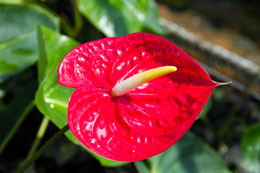The different aspects of anthurium care are presented in this following article. Anthuriums which are easy to care for can produce healthy flowers with proper care.

The anthurium is a genus of 600 - 800 species and is found in neo-tropical regions. This plant is also referred to by names like 'Boy Flower', 'Tail Flower', and 'Flamingo Flower'. Most anthurium species are found in wet tropical regions. The care for these tropical plants is an easy process. This flowering plant can be raised without much problems, if the following steps are implemented.
Culture for Growth
The soil to be chosen for growing anthuriums should be well-drained and coarse. The culture media for anthurium should contain peat moss, perlite, and pine bark in 1:1:1 ratio. Anthurium plants though, require a coarse potting medium, young saplings should be cultured in soils which hold enough water.
Planting
Roots of saplings need to be placed firmly in the soil. After planting a sapling, it should be watered adequately. The pot being used should have drainage holes. There is no need to have pots with depth greater than 6 inches. Since the anthurium needs bright light, it should be placed 5 - 6 feet from the window. However, the plants should never be placed in direct sunlight. It results in adverse effects on flowering; the flowering might slow down or even stop completely.
Watering
It is recommended to water the plant after the soil has slightly dried. Watering them once a week wouldn't cause problems if the soil holds enough water. One thing that should be kept in mind is maintaining optimum moisture levels of soil. Anthurium plants are found in tropical regions and therefore, desired levels of humidity should be maintained for their proper growth. The leaves should be misted frequently to keep them fresh.
Fertilizers
The fertilizers to be used for promoting healthy growth of anthuriums should be those with high content of phosphoric acid. It is recommended to use water-based fertilizers. Packages of such fertilizers have all the instructions required to prepare the necessary dilutions.
Repotting
The practice of repotting is useful in keeping anthuriums healthy. It is recommended to repot these plants every year. Before carrying out repotting of anthuriums, one should check whether they have healthy roots. Dividing the plant into two and then placing them in separate containers completes the process of repotting.
Pests and Diseases
Common pests which affect the growth of anthurium are aphids, mealy bugs, scales, and thrips. Insects like thrips and mealy bugs can be found on tender leaves. Use of appropriate pesticides in a timely manner should control the pests easily.
Tips for Anthurium Care
The following tips would come in handy for growing healthy anthuriums.
- It is necessary to protect these plants from temperature fluctuations.
- Dead leaves and brown flowers need to be removed in a timely manner. It prevents any kind of disease from affecting the plant.
- The anthuriums should be allowed to dry out only slightly, before the next watering. Excessive drying may cause damage to the root tips.
- Sometimes over-fertilizing leads to yellowing of leaves. One can overcome this problem by watering (drenching the soil) the plant with lukewarm water. It helps in draining out excess amount of nutrients present in the soil. The plant should again be watered after half an hour.
The anthurium produces flowers year round and their proper care would lead to good yield of brightly colored blooms. Temperature requirements of anthuriums for day and night are 78 - 90°F and 70 - 75°F respectively.






 The anthurium is a genus of 600 - 800 species and is found in neo-tropical regions. This plant is also referred to by names like 'Boy Flower', 'Tail Flower', and 'Flamingo Flower'. Most anthurium species are found in wet tropical regions. The care for these tropical plants is an easy process. This flowering plant can be raised without much problems, if the following steps are implemented.
The anthurium is a genus of 600 - 800 species and is found in neo-tropical regions. This plant is also referred to by names like 'Boy Flower', 'Tail Flower', and 'Flamingo Flower'. Most anthurium species are found in wet tropical regions. The care for these tropical plants is an easy process. This flowering plant can be raised without much problems, if the following steps are implemented.